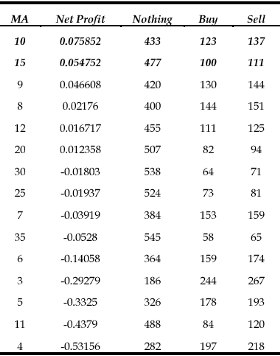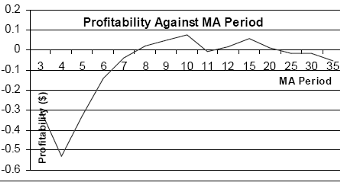Similar methodology is employed in this part of the test, and the data used starts from 1st January 1986 to 23rd June 1999. The total number of data in the sample is 702 weeks and the best comparative results are presented in the following table:

Table 4: Result Summaries for Different Moving Averages with and without Filters. The data used is from 1st January 1986 to 23rd June 1999. The performance of the system is measured in terms of Net Profit, those lines in bold represent the highest profits. The results confirm the previous study that the best moving average combination is 5 and 50.
The results presented in the above table seem to confirm the previous test that the use of two moving averages outperforms the single moving average strategy. The use of filters improves the profitability in both cases, as it helps to remove any unprofitable trading signal. The best long moving averages used are 35 (thirty-five) and 50 (fifty) weeks, as anything shorter than that will be too sensitive for Australian Dollar market which has not been ’trend-less’ over time.
Support and Resistance – Full Series
The final technical rule is the trading range break out, where a buy signal is generated when the price break through the resistance level, which is defined as local maximum. Consequently, a sell signal is generated when the price breaks through the support level, which is the local minimum price. Fundamentally, the term support level refers to the price at which buyers are willing to step in and buy enough shares of stock to temporarily stop or possibly reverse a downtrend. Conversely, a resistance level is the price at which sellers are willing to sell enough quantity to temporarily stop and possibly reverse an uptrend. In this exercise, a support and resistance is used as a ’filter’ on the conventional moving average oscillator.
The measure of significance and future reliability of the support and resistance lines in technical analysis are directly related to the number of times that prices touch the lines and then reverse back. In this exercise, the single moving average trading system is utilised to generate buying and trading signals. Signals are then generated only when the foreign exchange price of the particular week is the local maximum or minimum of the period (the same period used for calculating moving average). For example, in 5 (five) week moving average, buying (selling) signal is generated only when the prices of the week is greater than the maximum (minimum) price over the past 5 (five) weeks. In this part of the test the same moving average periods as the previous section are used.
The results of the trading system using both moving averages and support and resistance are presented in the Table 5.


Table 5 and Chart 2: Result Summaries for Different Moving Averages with Support and Resistance measured in terms of Profitability The data used is from 1st January 1986 to 23rd June 1999. The performance of the system is measured in terms of Net Profit, those lines in bold represent the highest profits. The next columns represent the number of signals (Buy, Sell or Do Nothing) generated by the system Chart 3 represents profitability using different moving average periods.
The table shows that the profitability is highest when the periods used are 10 (ten) and 15 (fifteen) weeks. Unfortunately, the profitability of the trading system using this method does not exceed the previous methods explored. Chart 3 next to the Table 4 shows the profitability against moving average period used. The outlook of the chart only applies for the case of Australian Dollar, and has not been tested on any other foreign exchange markets. Even within the Australian Dollar itself, the trends may be entirely different for quotation on other basis like monthly or daily.
Prof. Clarence N W Tan and Herlina Dihardjo
Next: Conclusion
Summary: Index